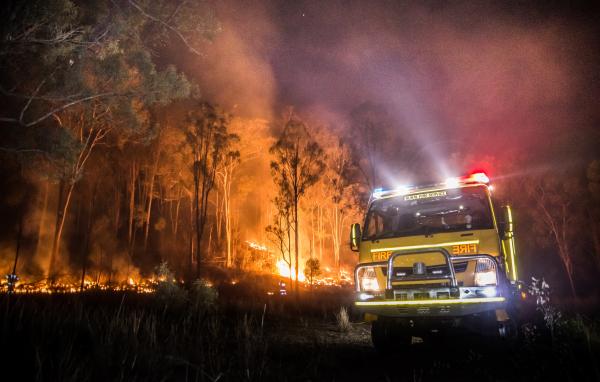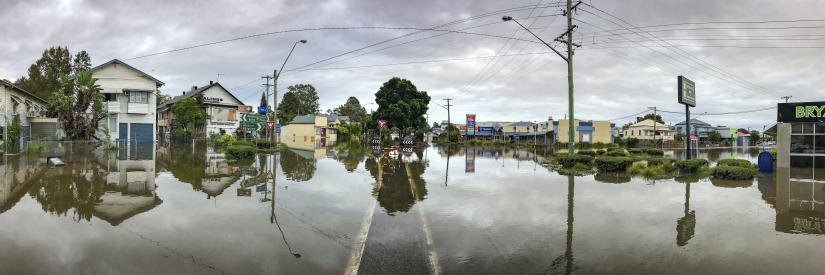The global challenges of climate change require solutions that respond to vulnerabilities at a regional scale. In Australia, the Institute for Sustainable Futures (ISF) is applying systems thinking to help guide the regions of the state of New South Wales to identify man-made and natural ‘systems’ – interconnecting networks – that are most at risk and develop pathways to help them adapt to current and projected climate impacts. Looking at weak spots in systems such as food production, urban and rural communities, environmental water availability, infrastructure and the economy helps decision-makers to consider the immediate impact of climate shocks and stressors and to plan for the flow-on effects to people and nature as these events intensify.
What systems? Defining the status quo
From 2013-2019, ISF partnered with the NSW Government to deliver a two-phased program to identify regional climate change vulnerabilities and risks, then map proposed pathways forward that would build regional climate resilience.
The first phase comprised a series of workshops in nine NSW regions. The workshops – a project of the Adaptive Communities Node of the NSW Government’s Adaptation Research Hub – brought together key decision-makers and researchers to discuss recent NSW and ACT Climate Modelling (NARCliM) and develop a shared understanding of the projected impacts of worsening storms, floods, droughts, and changing temperature patterns on their regions. Workshop participants were then able to identify the systems this would impact and to pinpoint the range of drivers (government processes, policies, market influences) that were supporting the status quo or driving change in the system. But beyond merely describing the current situation, each region also defined what systems would look like if they were climate resilient, thereby setting the desired adaptation goals.
The workshops provided a safe space to openly discuss the realities of climate change. For many participants, this was a rare opportunity to talk across policy silos and develop a sense of shared responsibility for tackling this challenge.
— Brent Jacobs, Institute for Sustainable Futures
The diverse backgrounds of local and state government decision-makers made this process quite unique. Associate Professor Brent Jacobs, ISF Research Director and AC Node Leader says, “The workshops provided a safe space to openly discuss the realities of climate change. For many participants, this was a rare opportunity to talk across policy silos and develop a sense of shared responsibility for tackling this challenge.”
Transition pathways: towards a new reality
Armed with a detailed picture of the challenges each region could expect and the required changes, the project moved into its second phase, the Enabling Regional Adaptation (ERA) Program. The objective of these follow-on workshops was to develop a series of ‘transition pathways’ for each vulnerable system. These pathways built on innovation in the current system and identified opportunities to bridge the gap between business-as-usual and a desirable future. Pathways covered a wide range of regional activities from changes to policy and planning, generation of new knowledge, information outreach to communities, and new, more inclusive models of community participation in governance. To make a start along the pathways, the workshops identified ‘first steps’ projects that often called for communities, government and business to work collaboratively.
…having representatives and leaders from all government sectors involved [built] awareness of regional climate resilience and challenges among a range of decision-makers within Government. This meant that the reports could then be used to inform policy and practice changes for local councils.
— Rebecca Cunningham, Institute for Sustainable Futures
The breadth and complexity of the issues at hand required input from the gamut of government agencies and organisations, among them Departments of Education, Industry, Planning and Environment, Primary Industries, Water, Public Works, Emergency Services, Police, Roads and Maritime Services and local councils in each region. Amongst a range of considerations were, for example, what governance models would be best suited to support systems adaptations, how to move towards those models and how economics would feature in systems transitions, how to protect biodiversity across regions in a changing climate, and how to implement circular economy principles that can benefit sustainability and climate change goals while increasing regional productivity.
The outcomes of this second round of workshops were captured in published regional reports that also included a list of proposed pilot projects to activate the pathways. Building a resilient community, for instance, could involve a project of personal emergency preparedness.
“One of the advantages of having representatives and leaders from all government sectors involved in the ERA workshops was that we build awareness of regional climate resilience and challenges among a range of decision-makers within Government. This meant that the reports could then be used to inform policy and practice changes for local councils,” according to Dr Rebecca Cunningham, social scientist and ISF Research Principal.
Leading the way – the NSW North Coast
One region particularly exposed to the effects of climate change is New South Wales’ North Coast; increasing rainfall and extended flooding frequently impact on its local communities as well as on its farming and tourism sectors. In 2018, the North Coast’s Enabling Regional Adaptation project (NERA) comprised four workshops facilitated by ISF researchers in partnership with the NSW Department of Planning, Industry and Environment (DPIE). In total, 154 participants were involved in reviewing the latest climate projections, considering the impacts on regional socioeconomic trends and policy processes, identifying key systems vulnerable to change, developing system change models with a range of pathways, and prioritising adaptation actions. Nine systems were noted as being particularly vulnerable across the region, among them settlement and land-use planning, cultural heritage, biodiversity, infrastructure and water, and emergency management.
Collaboration is the key to support policy and funding opportunities…
— Malcolm Robertson, NSW Department of Planning, Industry and Environment
The workshops involved representatives of all state and local government sectors with responsibilities in the region, opening up networking and collaboration opportunities that were unprecedented for many. The success of this approach on the North Coast has become evident since the project concluded. Encouraged by the momentum built through the workshops, the participants have continued their collaboration and formed the Transition North Coast (TNC) Working Group. Each agency member of the group now leads a pilot project proposed in the NERA report, signalling the collective commitment to the transition process. The impact of this ongoing commitment will lead to increasing systems changes as resources can be directed strategically with adaptation in mind.
“The Transition North Coast working group have been driving the coordination, collaboration and implementation of North Coast Enabling Regional Adaptation projects across regional agencies and councils. Collaboration is the key to support policy and funding opportunities, especially considering the changes that have emerged from the devastating bushfires in 2019/20.” Malcolm Robertson, Senior Project Officer, NSW Department of Planning, Industry and Environment.
The potential impact of applying systems thinking to climate adaptation planning at a regional scale is substantial, even if change can be slow initially. The North Coast region’s willingness to move quickly is likely to prove critical in light of the challenges anticipated under the changing climate.
The Enabling Regional Adaptation project builds on local knowledge to understand climate vulnerabilities in the state planning regions throughout NSW and identifies opportunities to respond. The project supports regional decision-makers to enhance government service delivery and planning at a regional and subregional scale in the context of climate change. The ERA process was designed in conjunction with the NSW DPIE to develop a shared understanding among regional stakeholders of the likely vulnerability to climate change and stimulate regional action to plan adaptation. Assessments have been completed for the NSW South East, Shoalhaven Illawarra, North Coast, Riverina Murray, New England North West, Central West Orana and Far West regions and are available on the AdaptNSW website.
RESEARCH OUTPUTS
Assessing regional vulnerability to climate change (Website)
Integrated regional vulnerability assessment of government services to climate change (2014) (Report)
Adaptation Planning Process and Government Adaptation Architecture Support Regional Action on Climate Change in New South Wales, Australia (2016) (Report)
The Towards a Resilient Sydney project: from Collective Assessment to Strategic Frameworks (2015) (Report)
Researchers
-
Associate Professor and Research Director
-
Research Director
-
Adjunct Fellow
-
Research Principal
Years
- 2013-2019










